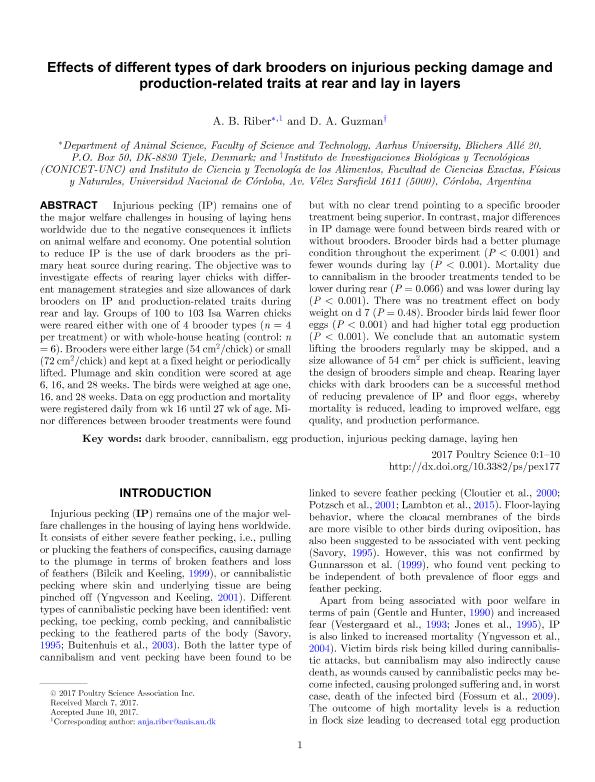Mostrar el registro sencillo del ítem
dc.contributor.author
Riber, Anja Brinch

dc.contributor.author
Guzmán, Diego Alberto

dc.date.available
2018-04-24T15:04:50Z
dc.date.issued
2017-10-10
dc.identifier.citation
Riber, Anja Brinch; Guzmán, Diego Alberto; Effects of different types of dark brooders on injurious pecking damage and production related traits at rear and lay in layers; Poultry Science Assoc Inc; Poultry Science; 96; 10; 10-10-2017; 3529–3538
dc.identifier.issn
0032-5791
dc.identifier.uri
http://hdl.handle.net/11336/43232
dc.description.abstract
Injurious pecking (IP) remains one of the major welfare challenges in housing of laying hens worldwide due to the negative consequences it inflicts on animal welfare and economy. One potential solution to reduce IP is the use of dark brooders as the primary heat source during rearing. The objective was to investigate effects of rearing layer chicks with different management strategies and size allowances of dark brooders on IP and production-related traits during rear and lay. Groups of 100 to 103 Isa Warren chicks were reared either with one of 4 brooder types (n = 4 per treatment) or with whole-house heating (control: n = 6). Brooders were either large (54 cm2/chick) or small (72 cm2/chick) and kept at a fixed height or periodically lifted. Plumage and skin condition were scored at age 6, 16, and 28 weeks. The birds were weighed at age one, 16, and 28 weeks. Data on egg production and mortality were registered daily from wk 16 until 27 wk of age. Minor differences between brooder treatments were found but with no clear trend pointing to a specific brooder treatment being superior. In contrast, major differences in IP damage were found between birds reared with or without brooders. Brooder birds had a better plumage condition throughout the experiment (P < 0.001) and fewer wounds during lay (P < 0.001). Mortality due to cannibalism in the brooder treatments tended to be lower during rear (P = 0.066) and was lower during lay (P < 0.001). There was no treatment effect on body weight on d 7 (P = 0.48). Brooder birds laid fewer floor eggs (P < 0.001) and had higher total egg production (P < 0.001). We conclude that an automatic system lifting the brooders regularly may be skipped, and a size allowance of 54 cm2 per chick is sufficient, leaving the design of brooders simple and cheap. Rearing layer chicks with dark brooders can be a successful method of reducing prevalence of IP and floor eggs, whereby mortality is reduced, leading to improved welfare, egg quality, and production performance.
dc.format
application/pdf
dc.language.iso
eng
dc.publisher
Poultry Science Assoc Inc

dc.rights
info:eu-repo/semantics/openAccess
dc.rights.uri
https://creativecommons.org/licenses/by-nc-nd/2.5/ar/
dc.subject
Dark Brooder
dc.subject
Cannibalism
dc.subject
Egg Production
dc.subject
Injurious Pecking Damage
dc.subject
Laying Hen
dc.subject.classification
Biología

dc.subject.classification
Ciencias Biológicas

dc.subject.classification
CIENCIAS NATURALES Y EXACTAS

dc.title
Effects of different types of dark brooders on injurious pecking damage and production related traits at rear and lay in layers
dc.type
info:eu-repo/semantics/article
dc.type
info:ar-repo/semantics/artículo
dc.type
info:eu-repo/semantics/publishedVersion
dc.date.updated
2018-04-16T14:06:02Z
dc.identifier.eissn
1525-3171
dc.journal.volume
96
dc.journal.number
10
dc.journal.pagination
3529–3538
dc.journal.pais
Estados Unidos

dc.description.fil
Fil: Riber, Anja Brinch. Department Of Animal Science, Aarhus University; Dinamarca
dc.description.fil
Fil: Guzmán, Diego Alberto. Universidad Nacional de Córdoba. Facultad de Ciencias Exactas Físicas y Naturales. Instituto de Ciencias y Tecnología de los Alimentos; Argentina. Consejo Nacional de Investigaciones Científicas y Técnicas. Centro Científico Tecnológico Conicet - Córdoba. Instituto de Investigaciones Biológicas y Tecnológicas. Universidad Nacional de Córdoba. Facultad de Ciencias Exactas, Físicas y Naturales. Instituto de Investigaciones Biológicas y Tecnológicas; Argentina
dc.journal.title
Poultry Science

dc.relation.alternativeid
info:eu-repo/semantics/altIdentifier/url/https://academic.oup.com/ps/article-abstract/96/10/3529/4055754
dc.relation.alternativeid
info:eu-repo/semantics/altIdentifier/doi/http://dx.doi.org/10.3382/ps/pex177
Archivos asociados
